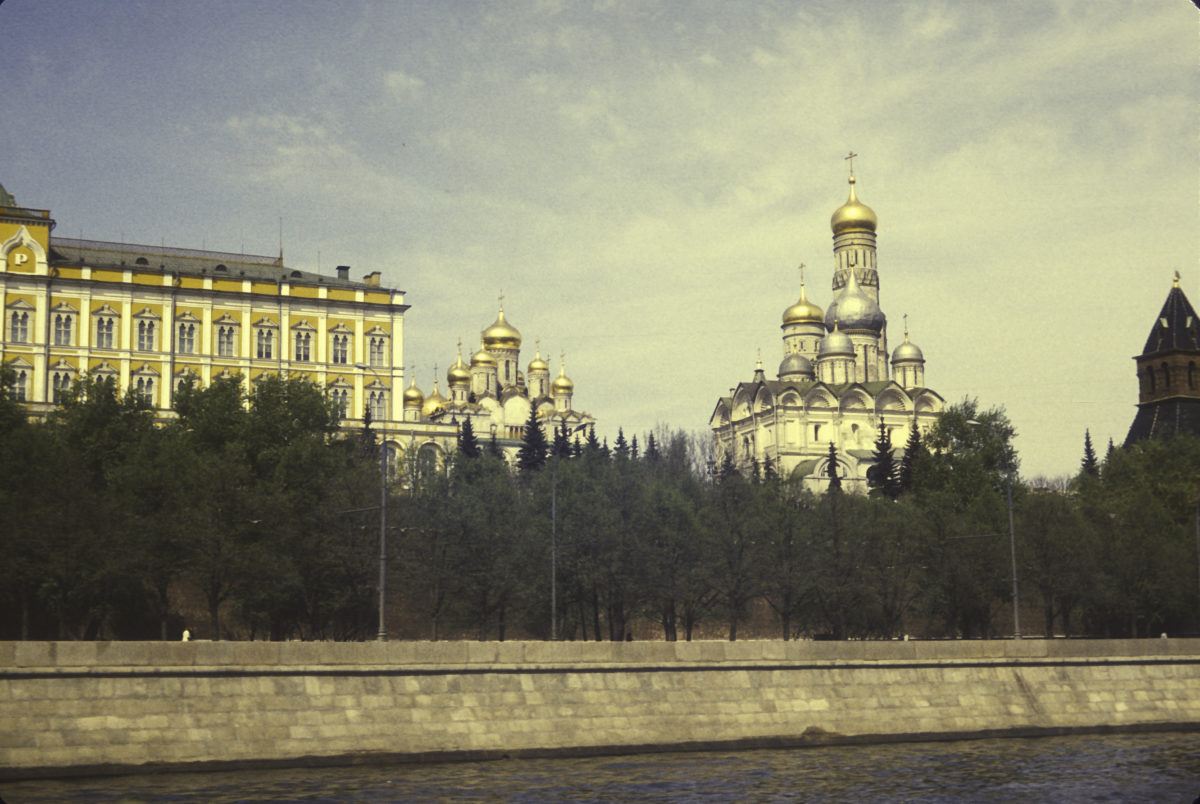Early on during my year in the Soviet Union, I took a sightseeing cruise down Moscow River. This is a good way to become acquainted with the layout of the city and some of the major landmarks. Of these the most famous and spectacular is, of course, the Kremlin, with its towers, palaces and cathedrals. But the cruise also provided me an opportunity to become acquainted not only with the major tourist attractions by the river, but also with a number of less well-known sights which don’t make it into the usual “must-see” lists but profoundly enriched my experience of Moscow.
The Moscow River meanders through the city from northwest to southeast in a series of great loops. Moscow University, where I was based, lies at the south end of one of these loops, and the Kremlin lies at the north end, where the river turns south again to form another great loop. Just before the river turns from south to north to form the loop that runs by the University, it passes the Novodevichy Convent, and that is where I’ll begin.
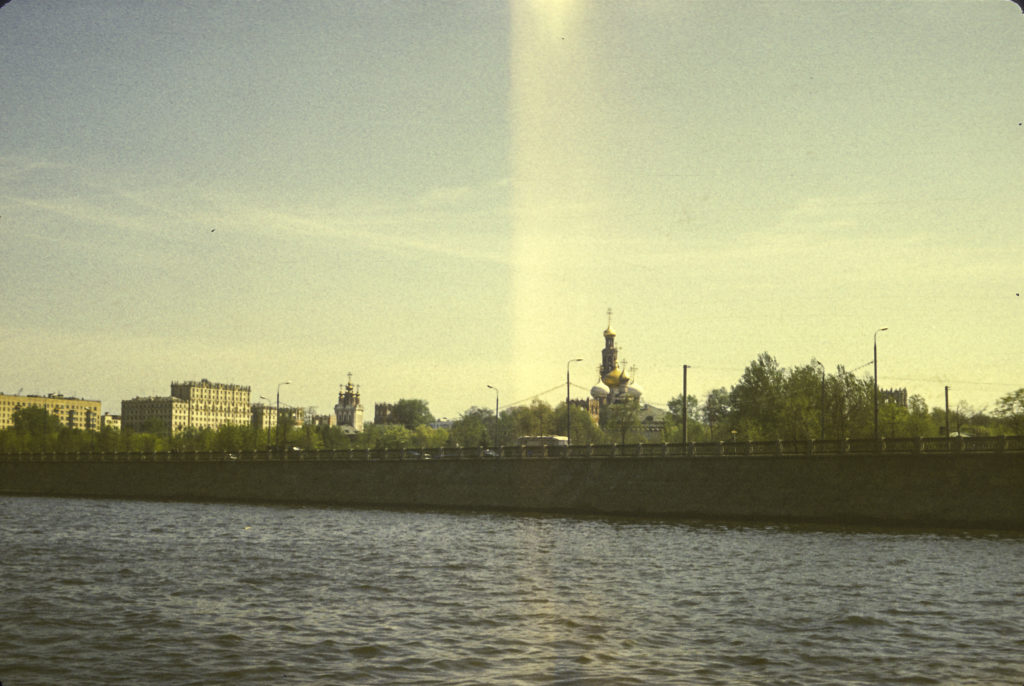
The Novodevichy Convent dates from 1524, when Grand Prince Vasily III founded it to commemorate his conquest of Smolensk, and indeed the oldest structure and main church, which was built at that time, is named the Cathedral of Our Lady of Smolensk. It soon became the preferred place for the Muscovite aristocracy to send sisters, daughters, etc. whom they found inconvenient for one reason or another. One of its most famous residents was Peter the Great’s half-sister, Sofia Alexeevna, whom Peter forced to retire there after seizing power and ending her regency in 1689. Peter’s first wife, whom he divorced, also lived there toward the end of her life. It was Sofia Alexeevna who had the bell tower, the tallest structure in the convent, built in the 1680s.
The Soviets closed down the convent and turned it into a museum, but during World War II Stalin, in an effort to rally the Orthodox Church in support of the war effort, allowed it to resume a presence there, and since 1994 nuns have again been living in the convent.
Outside the south wall of the convent lies the Novodevichy Cemetery, which is the most fashionable place in Russia to be buried. Such notables as Anton Chekhov, Nikita Khrushchev, Sergei Prokofiev, Dmitri Shostakovich, Boris Yeltsin and Mstislav Rostropovich are interred there.
Continuing on around the bend of the river, past Moscow University, you come to the Luzhniki Metro Bridge (Luzhnetsky Metromost), a bridge which accommodates subway trains on the lower level and autos on the upper. It crosses the river from Sparrow Hills (the locale of Moscow University) on the south to the area of the Luzniki sports complex on the north side of the river, in Khamovniki district.
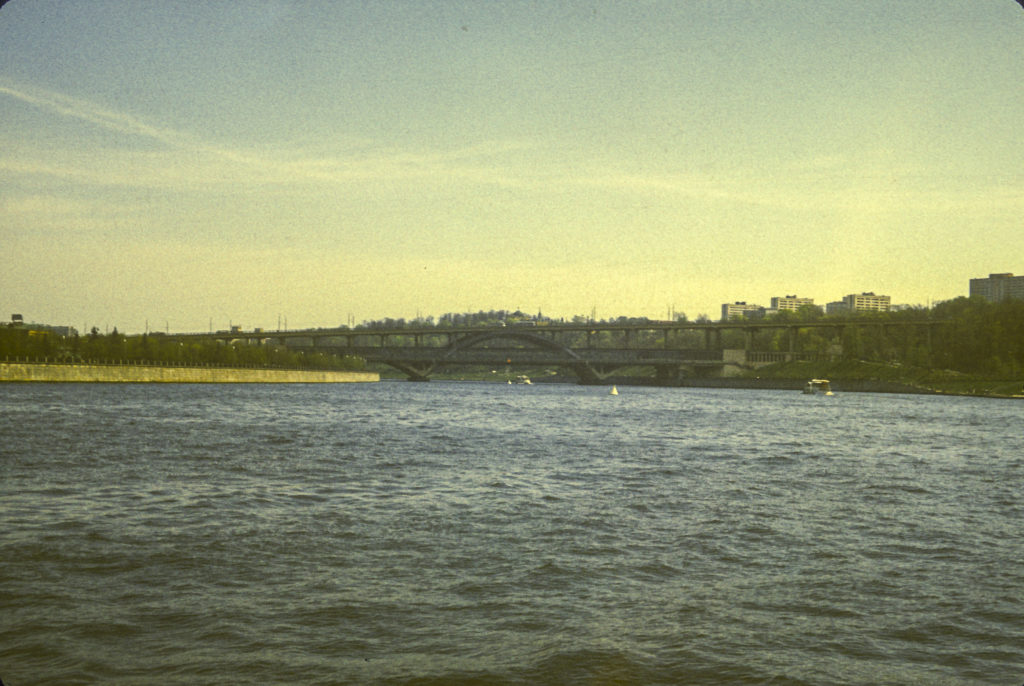
Continuing on up toward downtown Moscow, I passed the Church of Saint Nicholas in the Khamovniki district. This church is a prime example of a flamboyant architectural style flourishing in the later 17th century, featuring rows of tightly packed gables called kokoshniki, in which each arch represents a heavenly fire, and the ensemble of rows taken together symbolizes the throne of God. This type of church is called ognyonnyi khram (bonfire temple) in Russian. The church of St. Nicholas in Khamovniki was built in 1679-82; the bell tower, which retains the tented-roof style popular in the late 16th and early 17th century, was added in the 1690s. The church suffered badly in the fire following the Napoleonic occupation of Moscow in 1812 and was closed until 1849, but after that it remained open continuously, even during the Soviet period, during which it was said to have always been full.
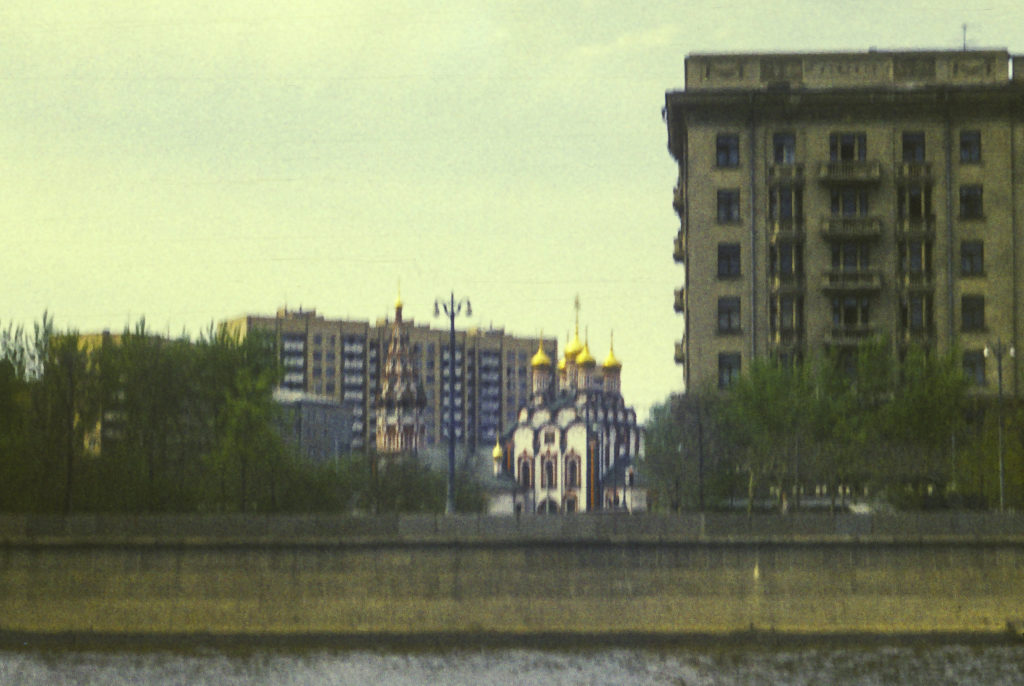
As you approach the center of Moscow, you come to an island in the river known variously as Bolotnyi (Swamp) Island or Balchug. This is an artificial island, created as a by-product of eighteenth-century flood control engineering. After a catastrophic flood in 1783, the main flow of the river was diverted into its present channel and the old riverbed was converted into what is now the Vodootvodnyi (Water Bypass) Canal. The Island sits between the two channels and constitutes the northernmost section of the Zamoskvorechye District. Situated directly across the river from the Kremlin, it contains some of the most expensive and sought-after real estate in Moscow.
The south end of the Island, known as Bersenevka, is now marked by a gigantic (322 feet high) monument to Peter the Great, designed by the sculptor Zurab Tsereteli to commemorate the founding of the Russian navy by that monarch. It consists of several ships piled atop one another with Peter himself standing on the topmost ship. It has been voted one of the ugliest monuments in the world and is said to be generally unpopular among Muscovites, who haven’t forgotten that Peter the Great hated Moscow and moved the capital to St. Petersburg.
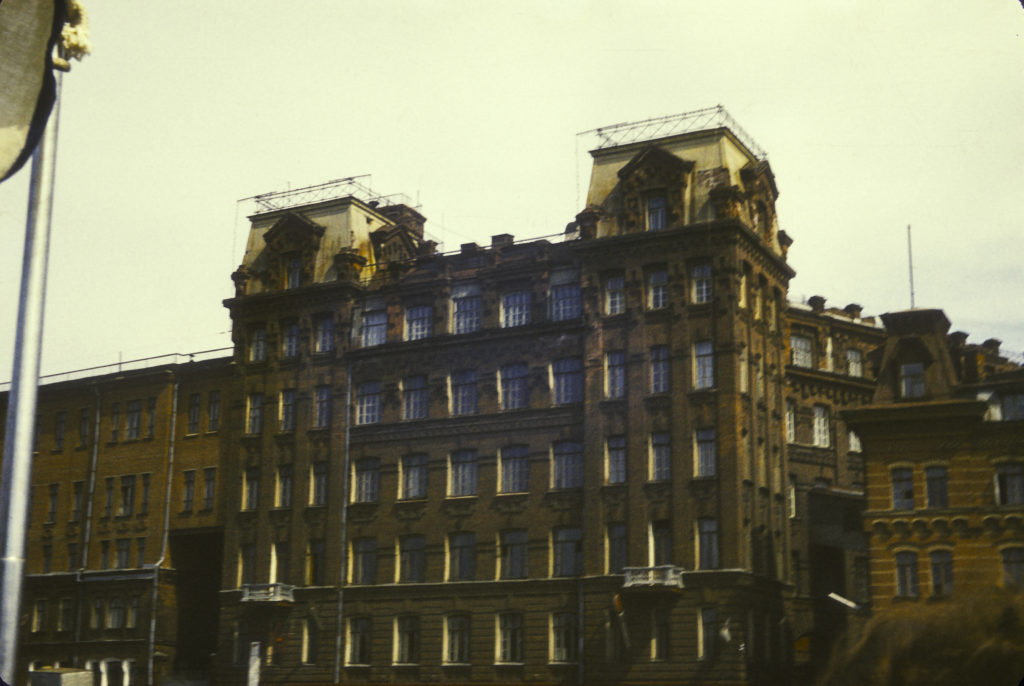
But that monument was erected in 1997, 27 years after I was there, so I have never seen it in person. A little way north of where it now stands, I photographed a set of brown buildings with a sign on top proclaiming “Glory to the Communist Party of the Soviet Union” (which sounds as ridiculous in Russian as it does in English). This was the Red October chocolate factory. It was founded in the 19th century by a German named von Einem and supplied confectionery to the Russian Imperial court until the Revolution of 1917, when it was nationalized by the Bolsheviks and renamed to Red October. After the collapse of the Soviet regime it was privatized. In 2007 the factory itself was relocated to the outskirts of Moscow, and today the old factory building houses various shops, restaurants, studios and offices, including the Deworkacy Red October coworking space, the Digital October Conference Center, the Boy Cut Red October barbershop, the Moscow Point Red October Hotel, and the news service Snob.ru. It has of course been spruced up a bit since then.
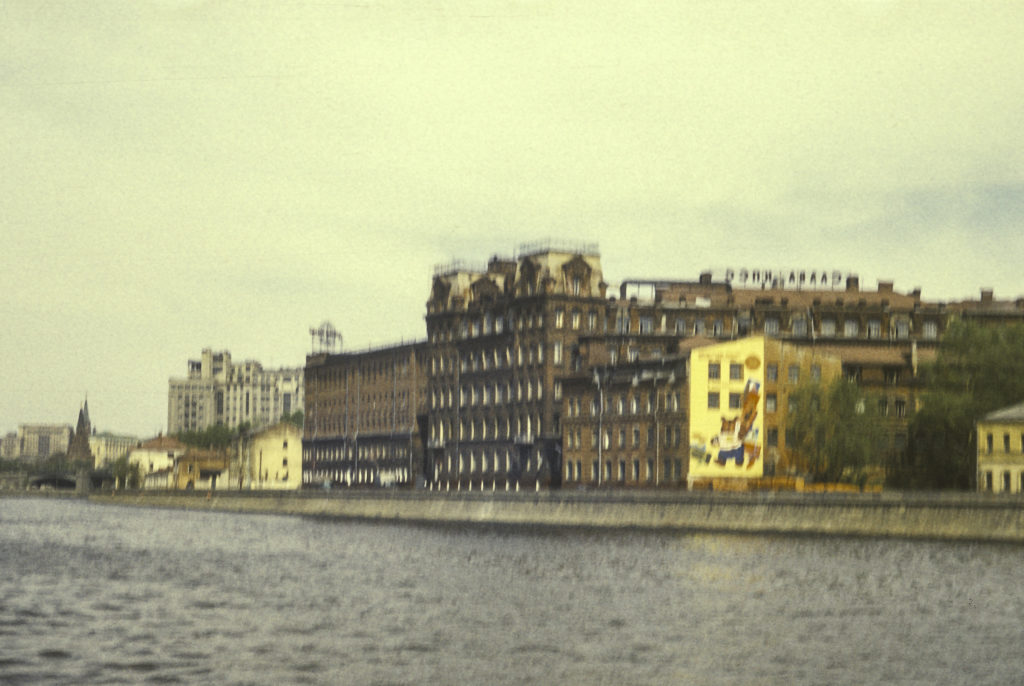
Downriver from the Red October) chocolate factory stood (and still stands) an apartment complex known today as the House on the Embankment (Dom na naberezhnoi in Russian), but formerly known as “Government House” (Dom Pravitelstva). This is a Constructivist-style structure built in 1931 to house civil servants, especially high-ranking ones, in apartments that were considered luxurious for the time. The architect was Boris Iofan, who also designed the Palace of Soviets, which was to be built on the site of the Cathedral of Christ the Savior (Khram Khrista Spasitelya), but became the site of the Moscow open-air swimming pool instead. Government House became notorious for the frequent and unremarked disappearances of its residents during the later 1930s – fully a third of them are said to have vanished without trace. Nowadays, the complex has shops and movie theaters as well as apartments. Although their amenities have been eclipsed by newer developments, the apartments are still very much in demand due to their location.
On the opposite side of the river from the Red October chocolate factory I observed an unusual mansion, which I was unable to identify at the time, but subsequent research has revealed it was built by a wealthy art collector named Ivan Tsvetkov in 1900 to house his collection of paintings.
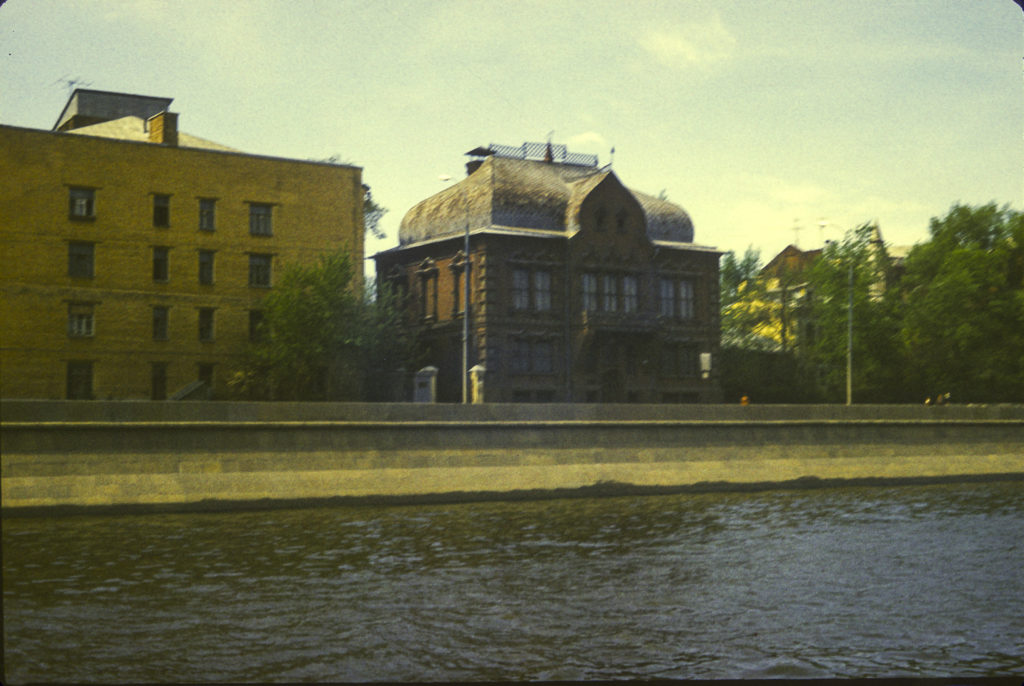
During World War II, the Tsvetkov Mansion was assigned to a military mission representing a Free French combat aviation unit, the Normandy-Niemen regiment, formed in the Soviet Union. Currently, the mansion houses the office of the French defense attaché as well as an exposition devoted to the history of the Normandy-Niemen regiment.
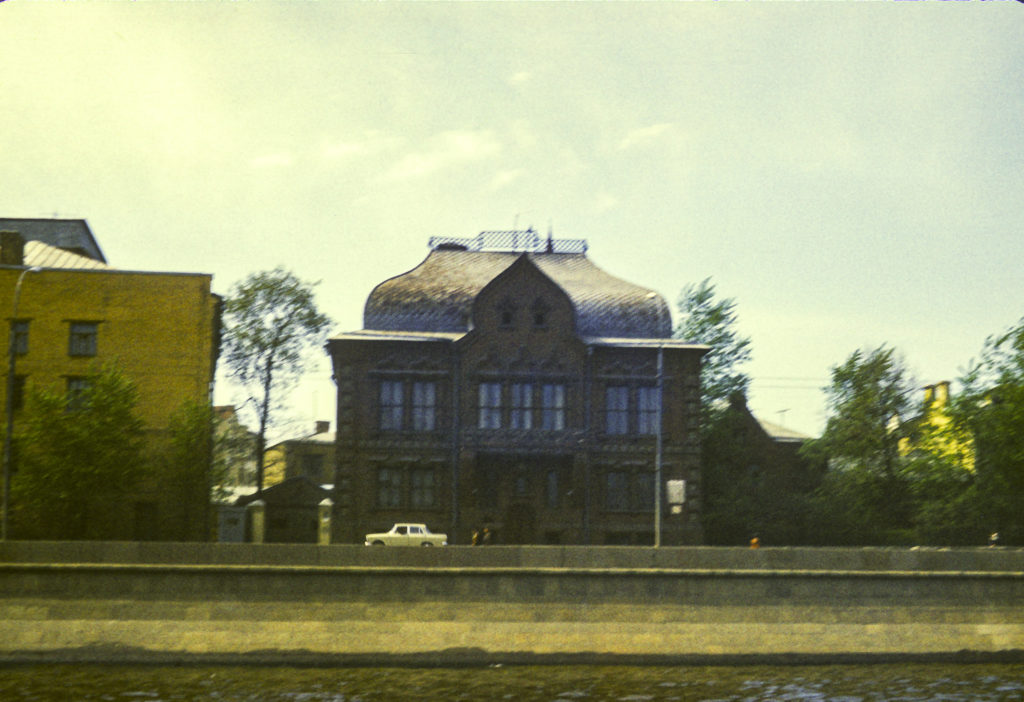
A few doors downstream from the Tsvetkov Mansion, I encountered an even more unusual house, which I was told was occupied by the Ethiopian Embassy. I doubt whether this was accurate, but I’ve since discovered that the house was built in 1905-07 by a well-to-do railway magnate named Petr Nikolayevich Pertsov, who intended it as a guest-house with residential apartments and workshops for artists and theatrical people.
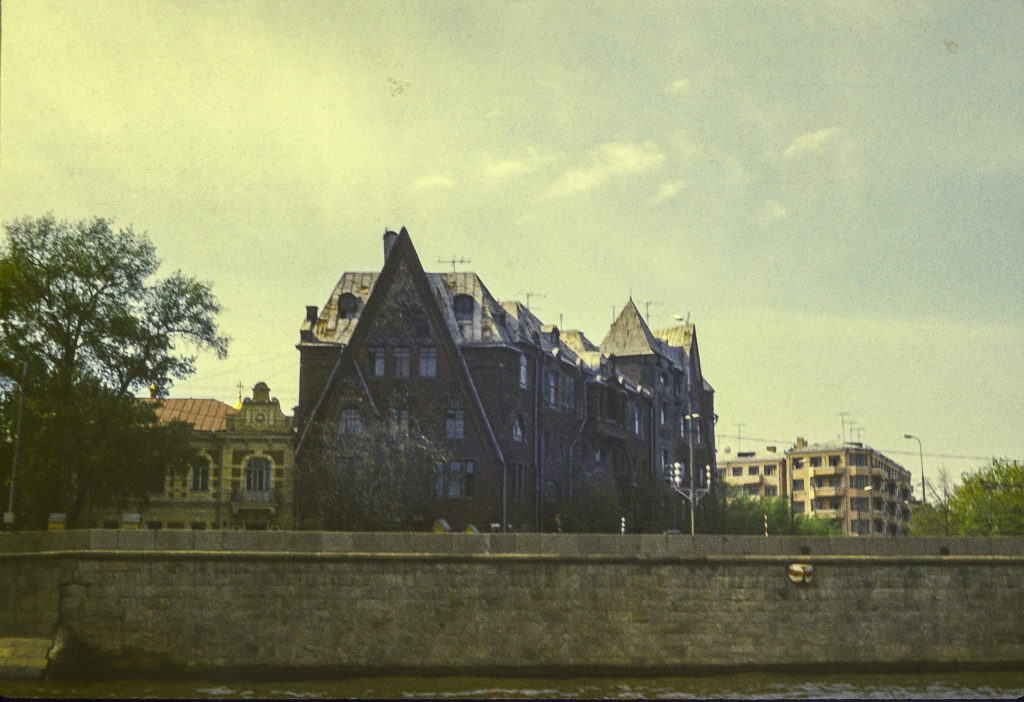
Tsvetkov may have sold or given Pertsov the land on which to build the house in return for a promise to make it a showcase of Russian art. In any case, it turned out to be a prime example of the flourishing of the art nouveau movement in Russia. If I had had a telephoto lens, I could have captured some of the extraordinary mosaics, figures of birds, animals, fantastic creatures and other decorations adorning the exterior of the building; you can view a few of them on Marina Pavljuk’s web page, which is a source for some of the information presented here. The artist responsible for the artwork was Sergei Maliutin, who is credited with originating the nested wooden Matryoshka dolls.
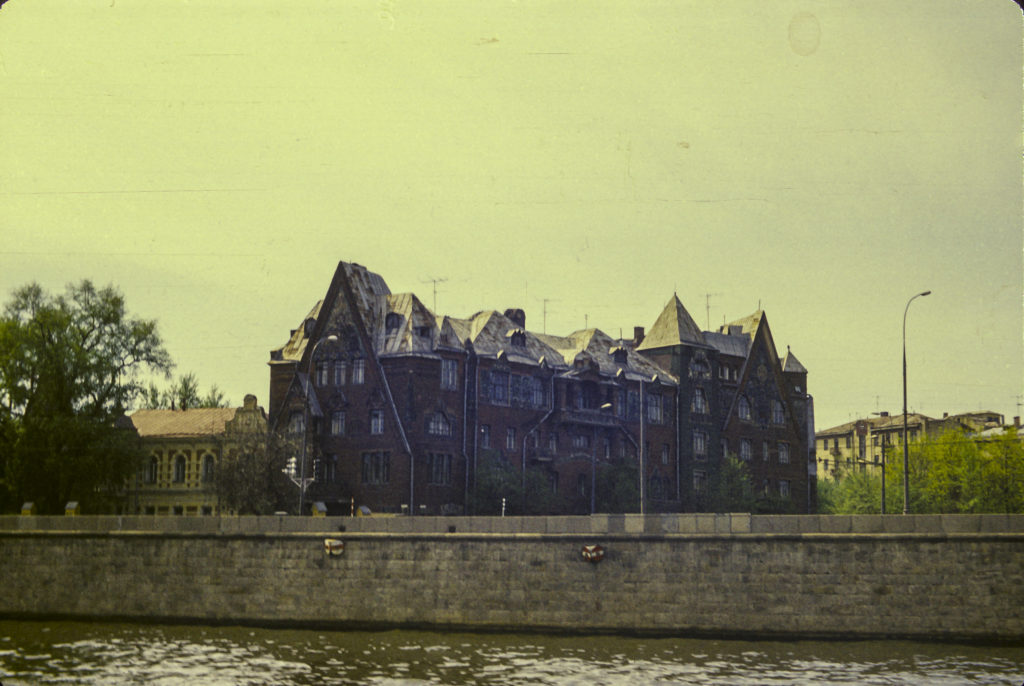
After the Revolution of 1917, the Bolsheviks confiscated the Pertsov house, as they did everything else, and turned it into a hostel for military officers. Nowadays it houses offices of the Foreign Ministry of the Russian Republic, so the interior remains closed to the public.
The Pertsov house is just a hop, skip and jump away from the next big attraction on the Moscow River, which is the Cathedral of Christ the Savior, but that, as I’ve noted elsewhere, did not exist when I was in Moscow in 1972-3. What did exist was the enormous outdoor swimming pool, which was not visible from Moscow River but which I had photographed in my earlier visit in 1964. I’ve included one of the badly faded color slides I bought in Moscow while I was there, just for laughs.
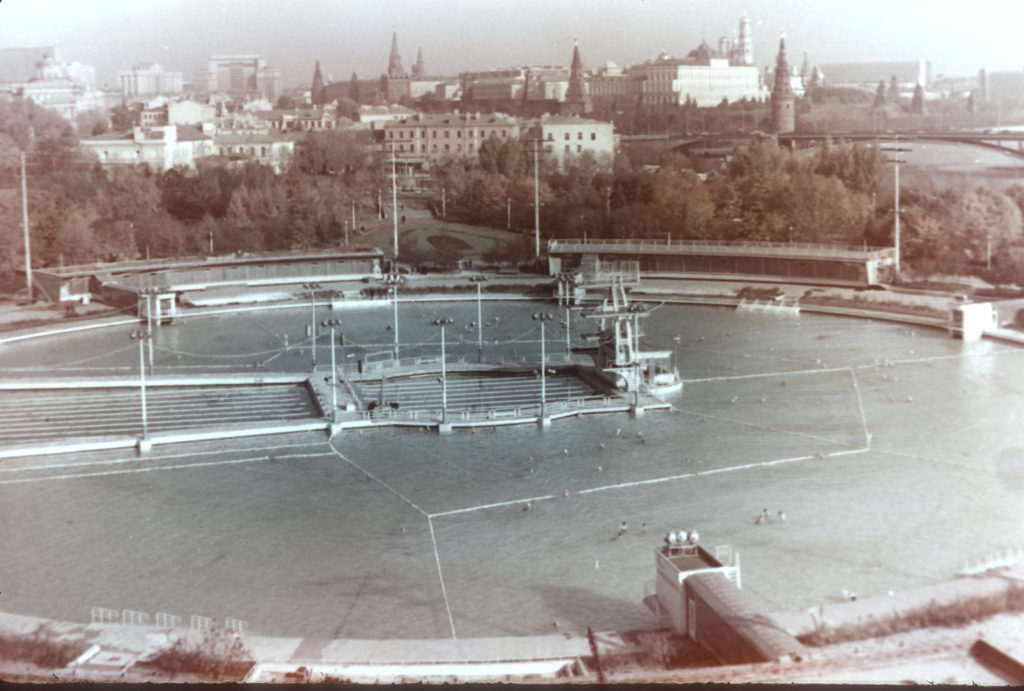
And so, after passing under the Big Stone Bridge (Bol’shoy Kamennyi Most), I came to the Kremlin. I had, of course, been inside the Kremlin walls in 1964, and had photographed the wonders within; in 1972-73 I went inside the Kremlin several times, but seeing it from the river provides a different perspective. Most immediately you notice the towers on the Kremlin wall, because they are right in front of everything else. Each tower has a name and its own story.
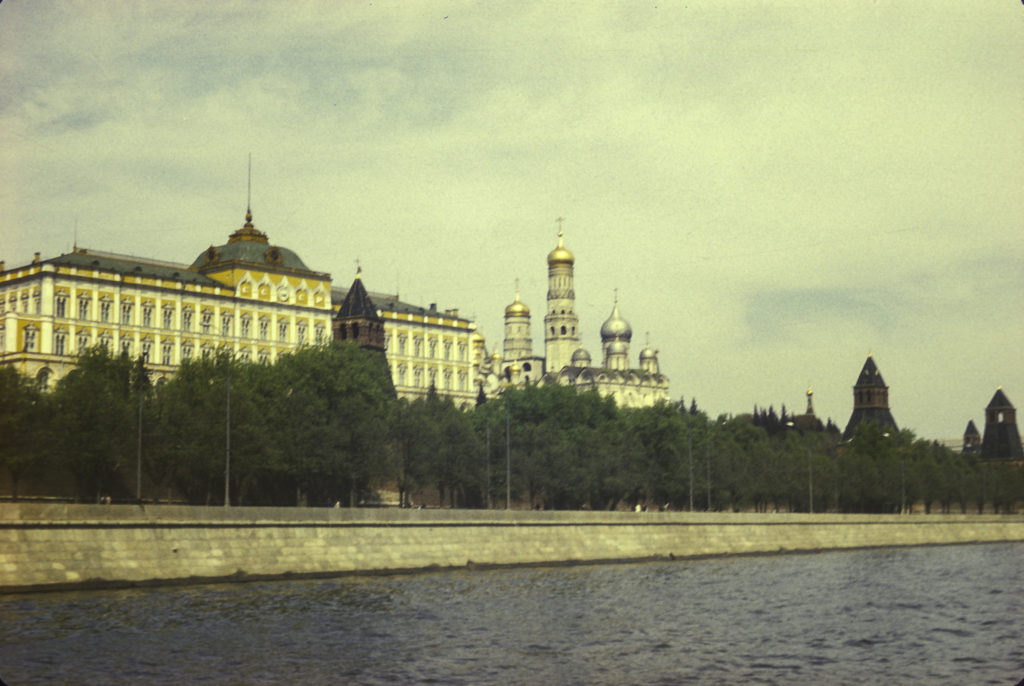
For example, the Blagoveshchenskaya Tower, pictured here, was built in 1488 and named for a miracle-working icon which was kept there. Ivan the Terrible used it as a prison. (Actually, there are two unnamed towers, but even these have names – the First and Second Unnamed Towers, respectively.)
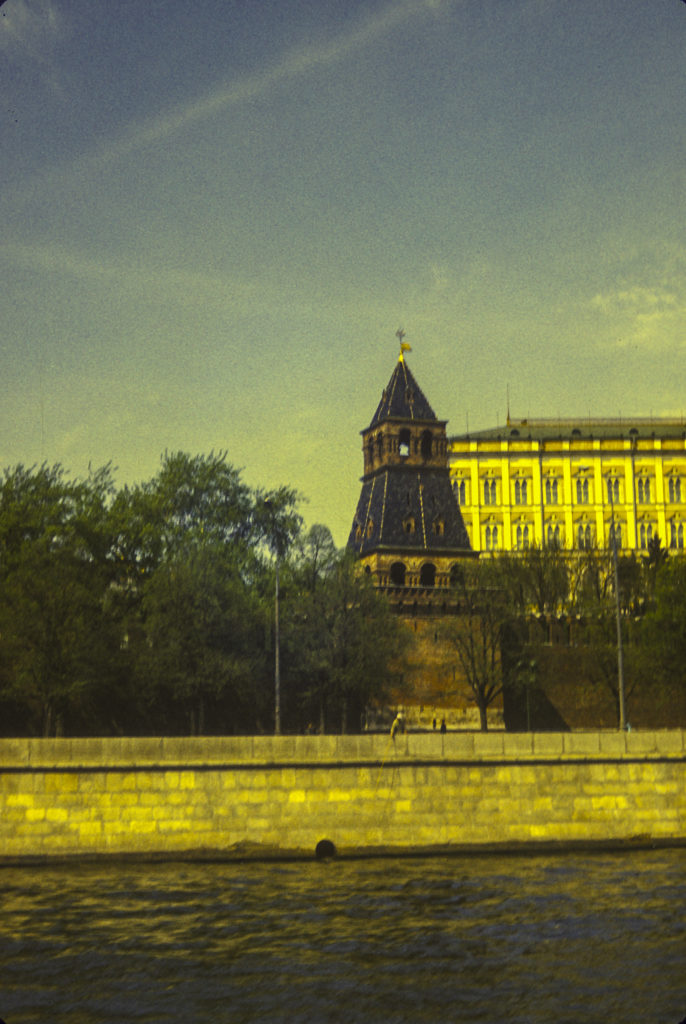
The Tainitskaya Tower, shown in the next picture, was so named (taina = “secret”) because it had a secret well, fed by a tunnel from the Moscow River. It was built in 1485. Like the Tainitskaya, the First and Second Unnamed Towers were built in the fifteenth century.
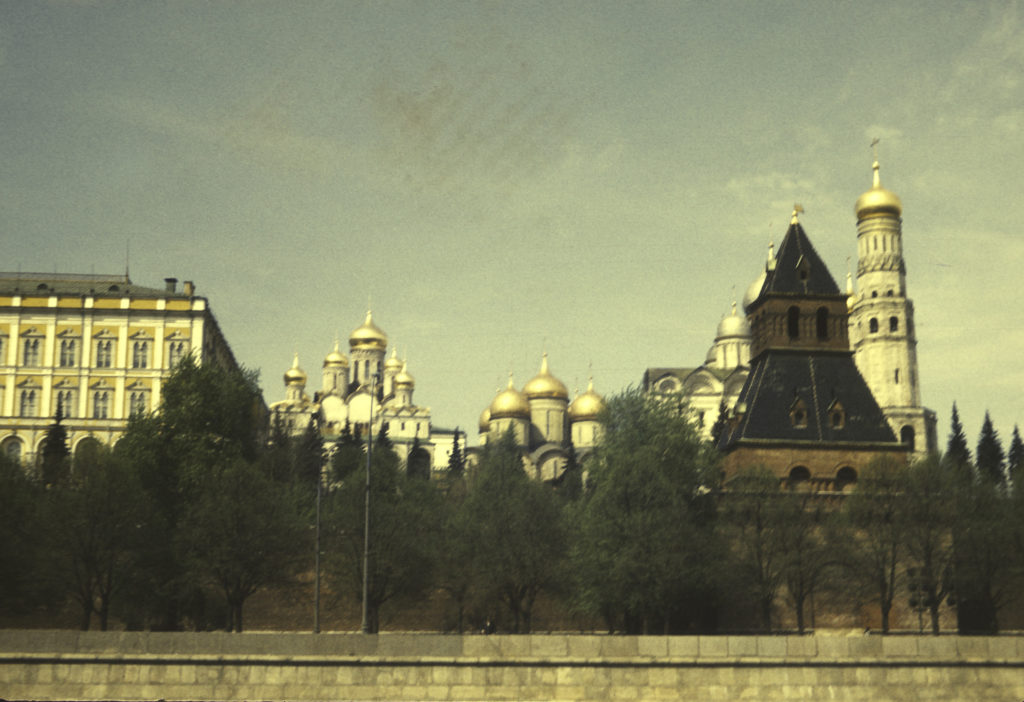
The Grand Kremlin Palace (Bol’shoi Kremlyovskyi Dvorets) was built during the reign of Nicholas I to be the Moscow residence of the Emperor; construction lasted from 1837 to 1849. The chief architect was Konstantin Andreevich Thon (or Ton), who also fulfilled that role for the Kremlin Armory and the Cathedral of Christ the Savior. I was surprised to find out that the Palace, which appears to have three stories, actually has only two, and that the two upper rows of windows both belong to the second floor. The Grand Kremlin Palace has an area of 25,000 square meters, over 700 rooms and five major reception halls. In the picture below, one may see the letters “CCCP” (which would be “SSSR” in the Latin alphabet, standing for “Soyuz Sovetskikh Sotsialisticheskikh Respublik”, i.e. Union of Soviet Socialist Republics) embedded between the pointed arches in the center section, between the windows and the roof; these were removed after the collapse of the Soviet Union.
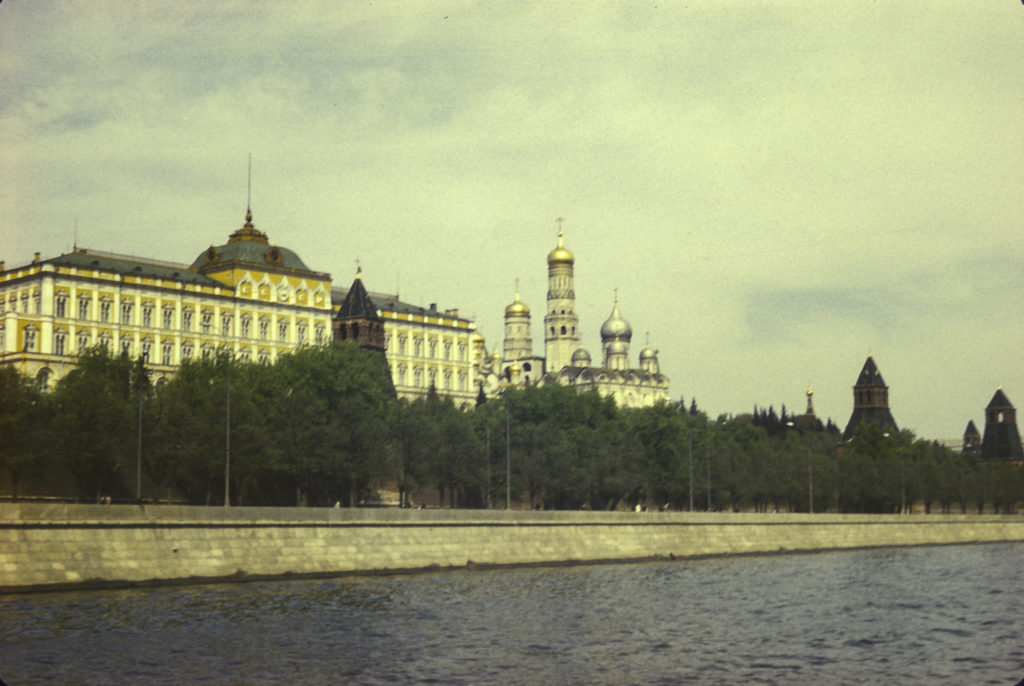
Of the three cathedrals in the Kremlin which are visible in the pictures displayed here, the oldest is the Uspensky Sobor (Cathedral of the Dormition), built between 1475 and 1479. It has five golden domes, symbolizing Christ and the Four Evangelists. It was the official venue for the coronation of Russian rulers from 1547 to 1896.
The next to be built was the Blagoveshchensky Sobor (Cathedral of the Annunciation), completed in 1489. Although it has nine golden domes, four more than the Uspensky, it is the smallest of the three major Kremlin cathedrals. It is the one immediately next to the Grand Kremlin Palace and is actually connected to the Palace. Ivan III had it built as his personal chapel, and from the time of Ivan IV it was the church where members of the royal family were baptized and got married.
The largest of the three, the Cathedral of the Archangel Michael, was begun in 1505 and completed in 1509. Ivan III died in 1505 and was buried there, as were his successors until the time of Peter the Great, when the Peter-Paul Cathedral in St. Petersburg became the burial place of the Russian rulers. The exception was Peter II, who died in Moscow and was buried in the Archangel Michael Cathedral.
The tallest structure in the Kremlin is not a cathedral but the Bell Tower of Ivan the Great. (Ivan III was called Ivan the Great because of his enormous appetite for gobbling up the lands of his neighbors – he tripled the territory of the Muscovite state – as well as for throwing off the Mongol yoke once and for all, promulgating a new law code and renovating the Kremlin.) Like the Archangel Cathedral, it was begun in 1505 and completed after Ivan’s death, in 1508. It has 22 bells, 18 small and 4 large. Napoleon Bonaparte tried to blow it up in 1812, but failed.
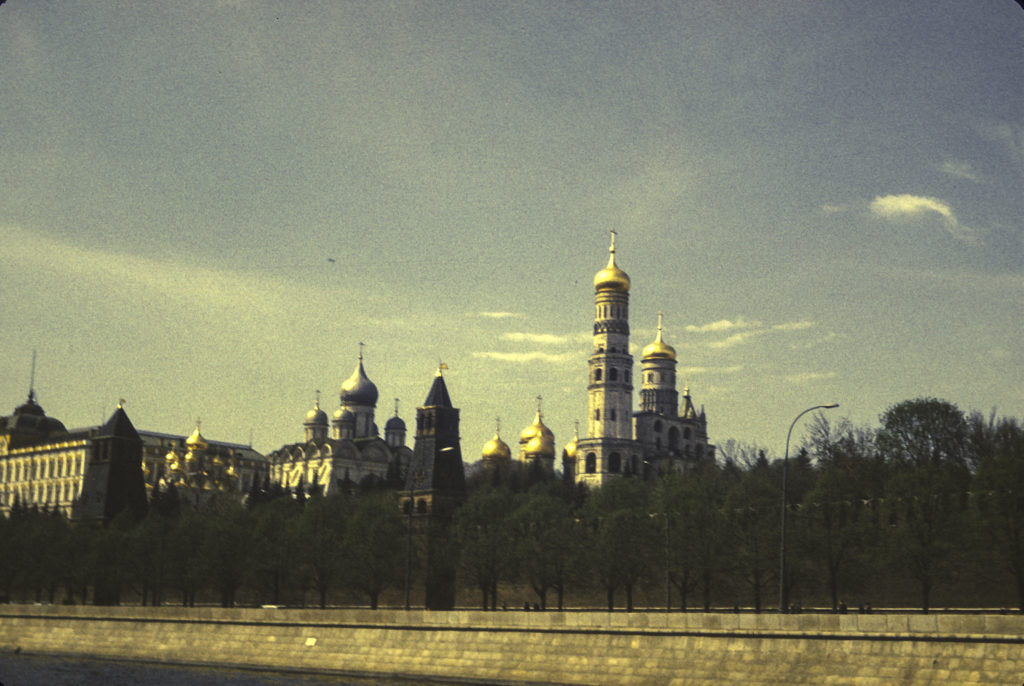
On Bolotny Island, directly opposite the Kremlin, stands the Saint Sophia Church in Middle Sadovniki (Khram Sofii Premudrosti Bozhiyey V Srednikh Sadovnikakh). Actually, from the river only the bell tower of the church is visible; the main part of the church is hidden behind the bell tower and obscured on either side by large waterfront buildings. I don’t know what was in the flanking structures in 1972, but today the headquarters of Rosneft (Russian Oil), the world’s largest publicly traded oil company and the third largest company in Russia (Gazprom and Lukoil being first and second respectively), occupies the right-hand building, while the one on the left belongs to the Ministry of Defense. The St. Sophia Church dates from the mid-17th century and is thought to have been established by merchants from Novgorod, where St. Sophia’s is the main center of worship. The church gave its name to the Sofia Embankment of the Moscow River, on which it stands. The Soviets closed the church in 1930 and turned it into communal apartments. It was reopened as a church in 2004 and now has its own web page.
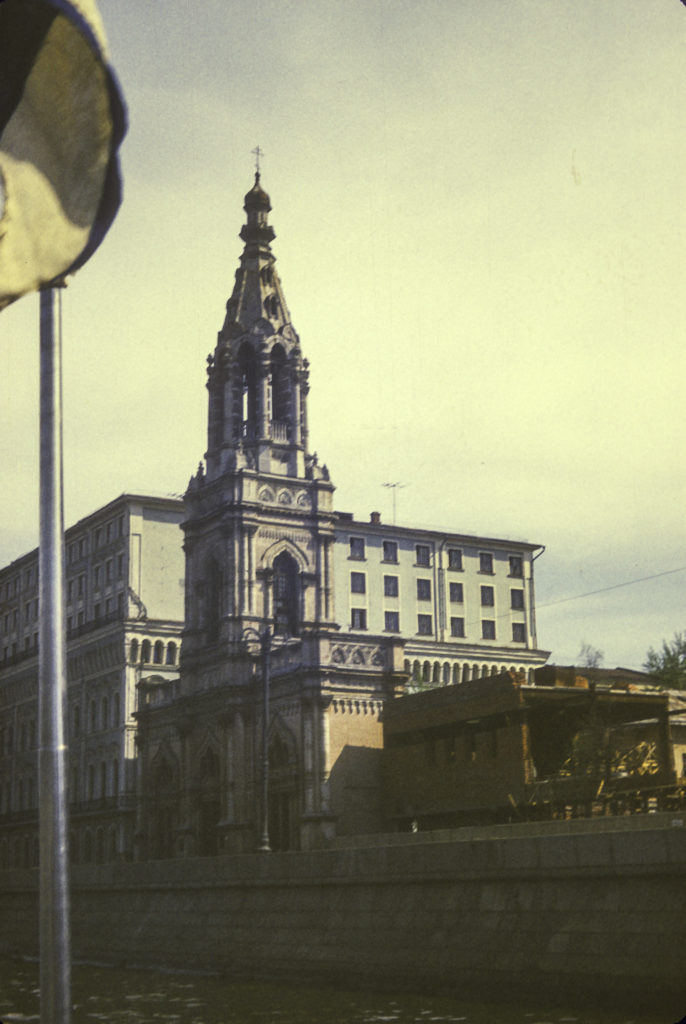
Continuing on past the Kremlin, I encountered the Hotel Rossiya. This was a gigantic hotel built in the Sixties, on the site of what was originally intended for the construction a Stalin-era skyscraper similar to Moscow University, the Hotel Ukraine and the other so-called “Seven Sisters.” The Zaryadye Administrative Building, as it was to be called, would have been the eighth Sister, but that project was canceled after Stalin’s death.
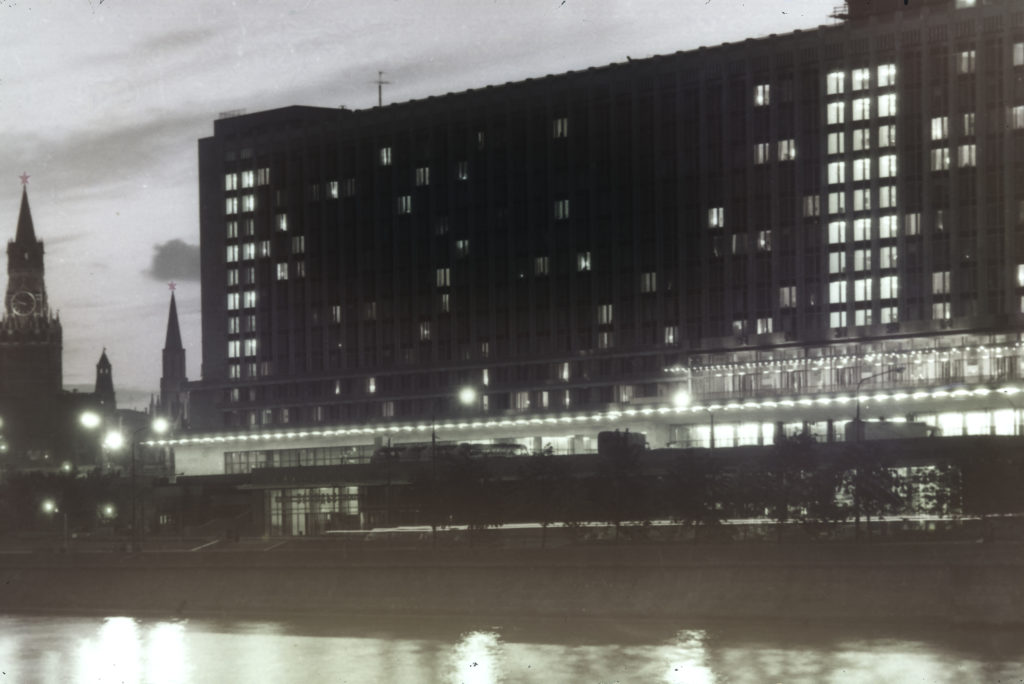
The Rossiya as finally built had 3,000 rooms, 245 half-suites, and a 2500-seat concert hall. Counting the central tower, which however was quite small in square footage compared to the main part of the hotel, it had 21 stories. It was designed to accommodate about 4,000 guests and was the largest hotel in the world until 1990, when it was topped by the Excalibur in Las Vegas, but it remained the largest in Europe until 2006.
One of its salient design peculiarities, dictated by the paranoiac Soviet emphasis on security and surveillance, was the paucity of exits. (I encountered the same situation in Moscow State University while I lived there.) This was intended to make it as difficult as possible for guests to enter or leave the building unseen, thereby making it easier for the hotel staff and security forces to keep track of their movements. But this feature had lethal consequences in 1977, when a major fire broke out in the hotel, resulting in the deaths of 42 people, some of whom perished because they couldn’t make it to the few available exits in time.
The hotel had other problems as well. It was noted for surly service, lousy food, ubiquitous cockroaches, bad beds, and radios that received only one station and could be turned off only by unplugging them. It was also considered an architectural blight, tasteless and ugly as well as incompatible with surrounding landmarks, such as the Kremlin. Finally, in 2006, it was demolished. At first the city government contemplated replacing it with another hotel, but eventually the site was converted into a park, which it remains today.
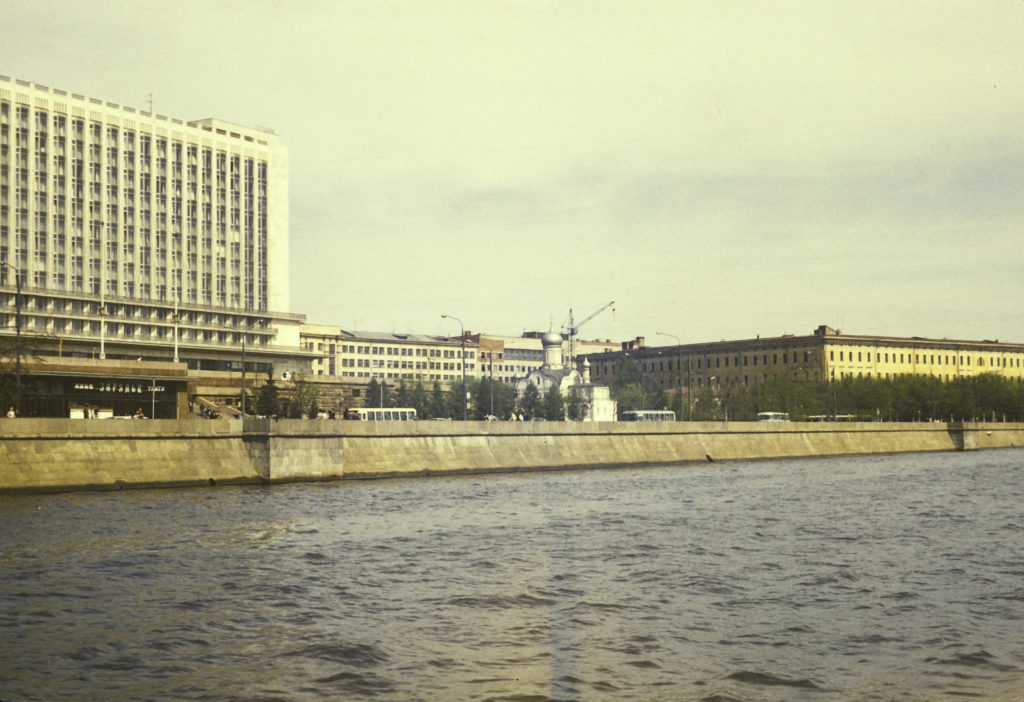
Next to the Hotel Rossiya, there stood and still stands a charming little Orthodox church with the improbable name of the Church of the Conception of St. Anna in the Corner on the Moat. I have not been able to find out much about this church, other than that it was built in 1493, and the picture I took of it is not very good; but you can see better pictures of it on the internet. The church survived both the construction of the hotel and its demolition, and now stands by itself in Zaryad’ye Park.
The last couple of photos from my Moscow River cruise are of the Novospassky (“New Savior”) Monastery. The “New” refers to the monastery rather than the Savior, and denotes the fact that it had an antecedent in the Kremlin. The Novospassky dates from 1491, but most of the buildings currently standing were erected in the 17th century. The Romanov family patronized the monastery in the 16th century, and it served as their burial ground. It was heavily fortified (note the white defensive towers anchoring the corners of the walls in the pictures) and withstood sieges by the Crimean Tatars, who sacked Moscow in 1571 and attacked again in 1591.
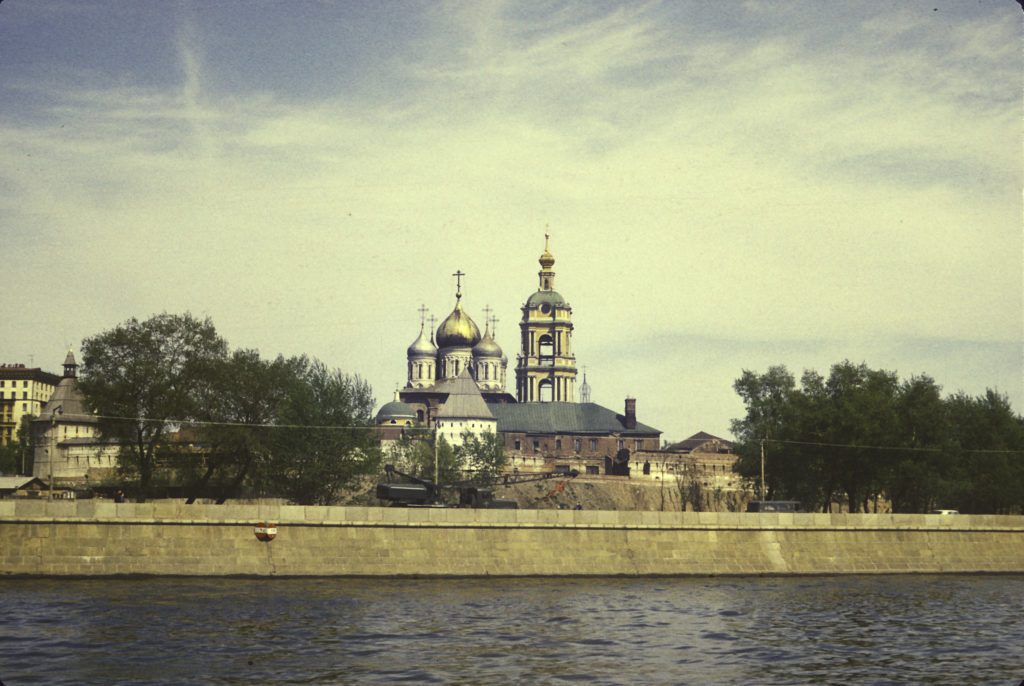
But the Novospassky really came into its own after the Romanovs became the ruling family of Muscovy in the 17th century. In the 1640s they commissioned the construction of the main cathedral of the monastery, the Preobrazhenskii Sobor (Cathedral of the Transfiguration), and other structures followed, including the grandiose bell tower in the 18th century.
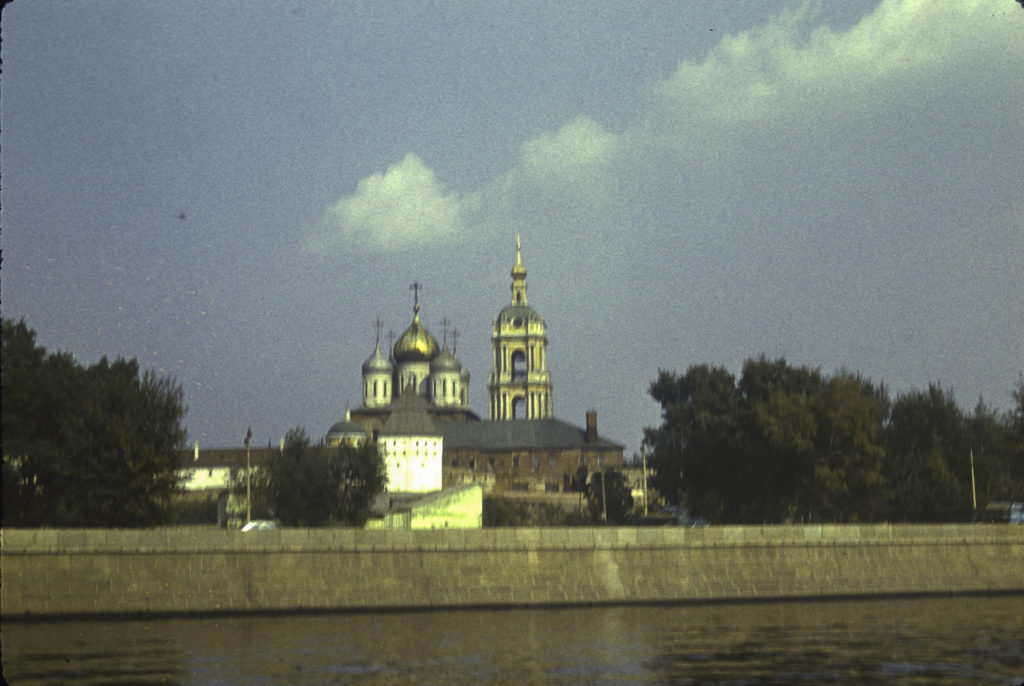
The Soviets used the monastery as a prison and a police drunk tank until the 1970s, when it was turned over to an art restoration institute; but it was returned to the Orthodox Church after the Revolution of 1991.
